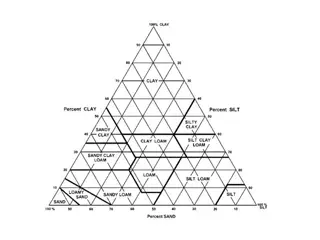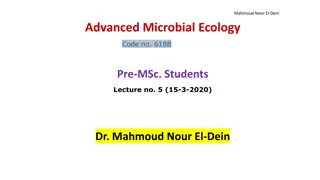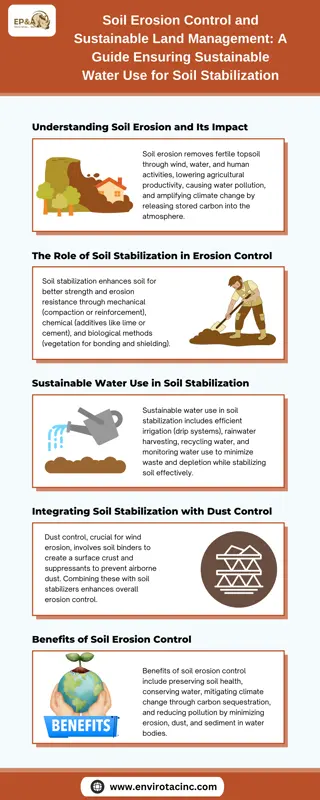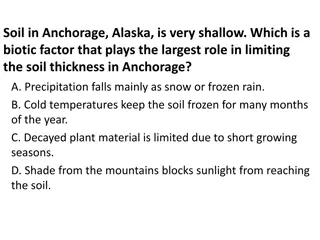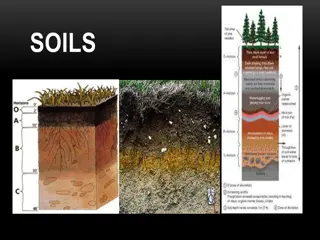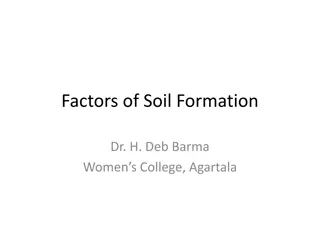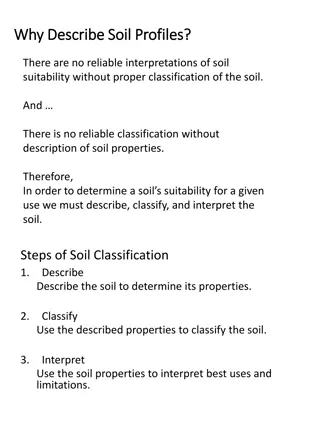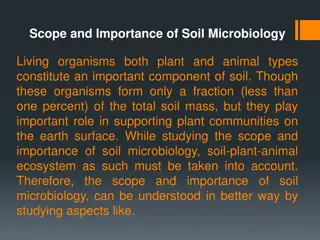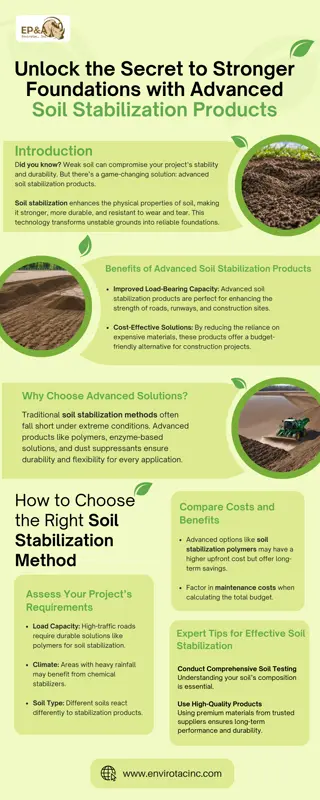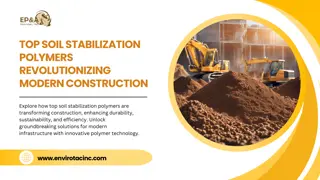Soil Stabilization Methods
Soil stabilization methods involve mechanical and chemical techniques to improve soil properties for engineering purposes. Mechanical stabilization blends different soil grades, while chemical stabilization involves mixing natural soil with agents like cement, asphalt binders, and lime. Cement stabilization creates soil cement with 5-14% cement content, enhancing soil strength and durability. Lime is effective in treating clayey soils, improving soil properties by 2-8% for coarse-grained soils and 5-8% for plastic soils. Stabilization aims for waterproofing and enhancing soil properties for construction projects.
Download Presentation

Please find below an Image/Link to download the presentation.
The content on the website is provided AS IS for your information and personal use only. It may not be sold, licensed, or shared on other websites without obtaining consent from the author.If you encounter any issues during the download, it is possible that the publisher has removed the file from their server.
You are allowed to download the files provided on this website for personal or commercial use, subject to the condition that they are used lawfully. All files are the property of their respective owners.
The content on the website is provided AS IS for your information and personal use only. It may not be sold, licensed, or shared on other websites without obtaining consent from the author.
E N D
Presentation Transcript
Third Stage Lecture 3 Lecture. Dr. RanaAmir Yousif Highway and Transportation Engineering Al-Mustansiriyah University 2017
References: 1. Nicholas J. Garber and Lester A. Hoel. Traffic and Highway Engineering , Fourth Edition. 2.Yoder; E. J. and M. W. Witczak, Principles of Pavement Design , A Wiley- Interscience Publication, John Wiley & Sons Inc., U.S.A., 1975. 3. Yaug H. Huang, Pavement Analysis and Design , Prentic Hall Inc., U.S.A., 1993. 4. AASHTO Guide for Design of Pavement Structures 1993 , AASHTO, American Association of State Highway and Transportation Officials, U.S.A., 1993. 5. Oglesby Clarkson H., Highway Engineering , John Wiley & Sons Inc., U.S.A.,1975.
Soil stabilization is the treatment of natural soil to improve its engineering properties. Soil stabilization methods can be divided into two categories, namely, mechanical and chemical. Mechanical stabilization is the blending of different grades of soils to obtain a required grade. Chemical stabilization is the blending of the natural soil with chemical agents. The most commonly used agents are Portland cement, asphalt binders, and lime. Mechanical stabilization: is the blending of different grades of soils to obtain a required grade. Chemical Stabilization: is the blending of the natural soil with chemical agents. Several blending agents have been used to obtain different effects. The most commonly used agents are Portland cement, asphalt binders, and lime.
The soil stabilized with cement is known as soil cement. Cement stabilization of soils usually involves the addition of 5 to 14 percent Portland cement by volume of the compacted mixture to the soil being stabilized. The cementing action is believed to be the result of chemical reactions of cement with siliceous soil during hydration reaction. The important factors affecting the soil cement are nature of soil content, conditions of mixing, compaction, curing and admixtures used. The procedure for stabilizing soils with cement involves: Pulverizing the soil Mixing the required quantity of cement with the pulverized soil Compacting the soil cement mixture Curing the compacted layer
Slaked lime is very effective in treating heavy plastic clayey soils. Lime may be used alone or in combination with cement, bitumen or fly ash. Sandy soils can also be stabilized with these combinations. Lime has been mainly used for stabilizing the road bases and the subgrade. The addition of lime leads to increase the strength and durability of soil. Normally 2 to 8% of lime may be required for coarse grained soils and 5 to 8% of lime may be required for plastic soils. The amount of fly ash as admixture may vary from 8 to 20% of the weight of the soil.
Stabilization is carried out to achieve one or both of the following: Waterproofing of natural materials Binding of natural materials Waterproofing the natural material through asphalt stabilization aids in maintaining the water content at a required level by providing a membrane that impedes the penetration of water, thereby reducing the effect of any surface water that may enter the soil when it is used as a base course. In addition, surface water is prevented from seeping into the subgrade, which protects the subgrade from failing due to increase in moisture content. Binding improves the durability characteristics of the natural soil by providing an adhesive characteristic, whereby the soil particles adhere to each other, increasing cohesion.
Soil mechanically construction, this is a significant part of the building process. If performed improperly, settlement of the soil could occur and result in unnecessary maintenance costs or structure failure. Almost all types of building sites and construction projects utilize mechanical compaction techniques. compaction is defined the as density the method of of In increasing soil.
Soil is formed in place or deposited by various forces of nature such as glaciers, wind, lakes and rivers residually or organically. Following are important elements in soil compaction: Soil type Soil moisture content Compaction effort required
There are five principle reasons to compact soil: Increases load-bearing capacity Prevents soil settlement and frost damage Provides stability Reduces water seepage, swelling and contraction Reduces settling of soil
There are four types of compaction effort on soil or asphalt: Vibration Impact Kneading Pressure
Every soil type behaves differently with respect to maximum density and optimum moisture. Therefore, each soil type has its own unique requirements and controls both in the field and for testing purposes. Soil types are commonly classified by grain size, determined by passing the soil through a series of sieves to screen or separate the different grain sizes. Soil classification is categorized into 15 groups, a system set up by AASHTO (American Association of State Highway and Transportation Officials). Soils found in nature are almost always a combination of soil types. A well-graded soil consists of a wide range of particle sizes with the smaller particles filling voids between larger particles. The result is a dense structure that lends itself well to compaction. Asoil s makeup determines the best compaction method to use. There are three basic soil groups: Cohesive Granular Organic (this soil is not suitable for compaction and will not be discussed here)
Cohesive soils have the smallest particles. Clay has a particle size range of .00004" to .002". Silt ranges from .0002" to .003". Clay is used in embankment fills and retaining pond beds. Characteristics Cohesive soils are dense and tightly bound together by molecular attraction. They are plastic when wet and can be molded, but become very hard when dry. Proper water content, evenly distributed, is critical for proper compaction. Cohesive soils usually require a force such as impact or pressure. Silt has a noticeably lower cohesion than clay. However, silt is still heavily reliant on water content.
Granular soils range in particle size from .003" to .08" (sand) and .08" to 1.0" (fine to medium gravel). Granular soils are known for their water-draining properties. Characteristics Sand and gravel obtain maximum density in either a fully dry or saturated state. Testing curves are relatively flat so density can be obtained regardless of water content. The tables on the following pages give a basic indication of soils used in particular construction applications.


